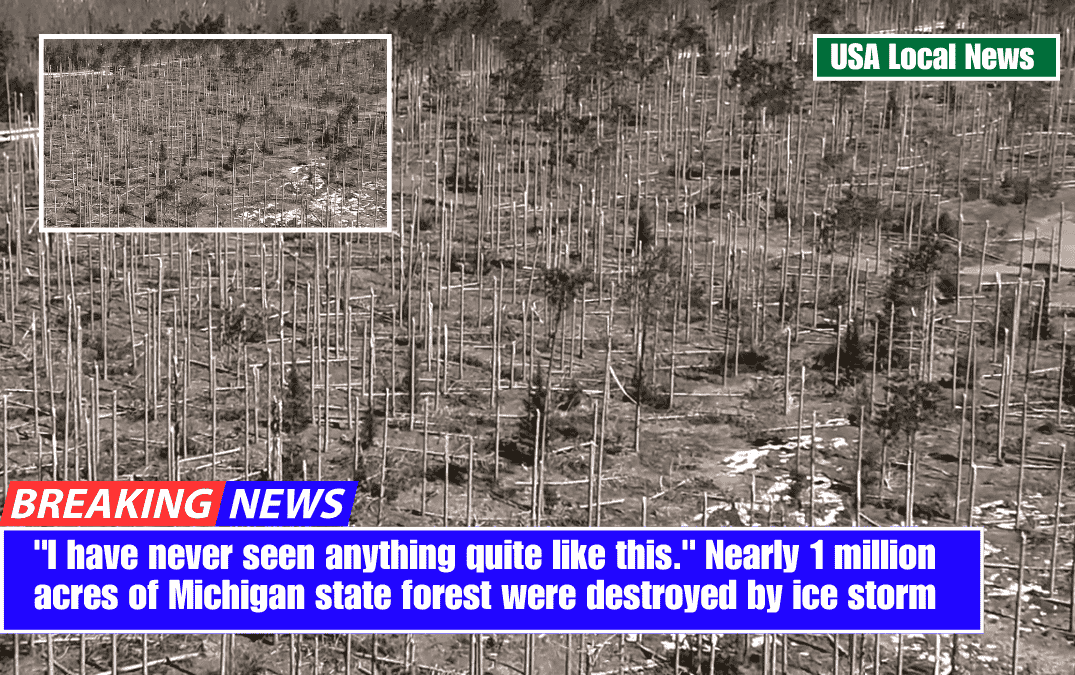Aerial images show that thousands of acres of state forest in Northern Michigan were damaged as a result of March’s severe ice storm.
The ice storm has impacted approximately 919,550 acres of state forest land, according to the Michigan Department of Natural Resources’ Forest Resources Division.
“I’ve worked for the state for 39 years, and I’ve never seen anything quite like this,” said Jeff Stampfly, Chief of the Forest Resources Division.
The DNR began drone flyover assessments of state forests on April 8.
The public was made aware of the extent of the damage when the DNR shared aerial footage of Pigeon River Country State Forest, also known as Michigan’s “Big Wild.”
Footage showed a red pine plantation reduced to stick-like figures after heavy ice snapped hundreds of trees’ tops off. The state forest is the largest undeveloped area of land in the Lower Peninsula.
Pigeon River Country, located just a few miles northeast of Gaylord, was one of the hardest hit areas.
The aerial assessment was conducted in Otsego County for the DNR’s Incident Management Team and the State Emergency Operations Center, according to Stampfly.
Otsego County is one of the 12 counties under Gov. Gretchen Whitmer’s State of Emergency declaration. Whitmer has also requested a presidential emergency declaration (EM) for the state of Michigan.
Currently, priorities are focused on state forest roadways to improve general transportation and emergency vehicle access.
On April 10, the Forest Resource Division estimated that the ice storm had impacted approximately 3,260 miles of state forest roads.
These difficult-to-access roads are contributing to delays in cleanup at five state forest campgrounds, which have already pushed back their spring opening dates.
The DNR stated that the initial estimates for acreage and roads may change as the team gains better access to the state forests to assess the damage.
Spring also brings the mushroom and turkey hunting season.
Stampfly strongly advises mushroom hunters to stay off state forest roads right now.
“It’s a real safety hazard right now,” he told me. “Many tops remain on the tree and may fall off if the wind blows.” If any of them hit someone, the consequences would be disastrous.”
Stampfly stated that the next steps will be to determine what happens after the emergency orders expire and the DNR is responsible for the remaining clean-up.
Aerial mapping will reveal how widespread the damage is, what timber types are involved, and the extent of the damage, Stampfly explained.
Before they begin salvaging and replanting the trees, the forestry team must first determine how much of their contracted timber sales have been impacted.
“Salvaged timber doesn’t get the same price that standing would have,” Stampfly told the audience. “[Timber] that was worth thousands of dollars the day before the storm is now automatically worth less due to the damage. We’ll try to salvage as much as we can, but we’ll never get it all.”
With so much timber on the ground, the forestry team is concerned about an increased risk of wildfires this spring and summer as branches and tree tops dry.
“I urge caution with debris burning because a lot of people are going to do it and it’s very easy for stuff to spread this year,” says Stampfly. “If it goes like we hope there will be a lot of logging activity in and around state land and probably going to see that on private land, too.”
Before burning, the DNR strongly advises residents to always check Michigan.gov/BurnPermit to see if it is permitted in their area. Before you start a fire, review the conditions.
More than a dozen state parks, as well as all state-managed trails in the 12 affected counties, have been closed while recovery efforts continue. Click here for up-to-date closures.
As of April 11, the DNR’s Incident Management Team, working with the Michigan National Guard and other partners, had cleared 750 miles of roadway.
The interactive map of road re openings can be accessed here.















